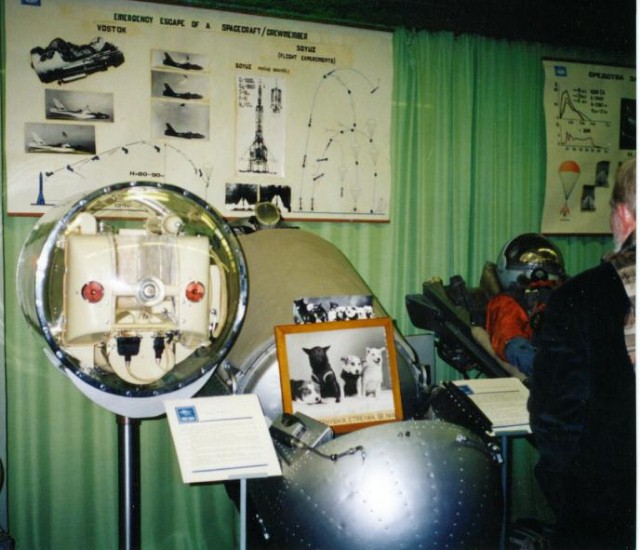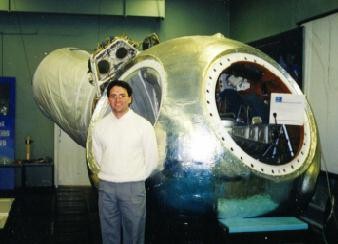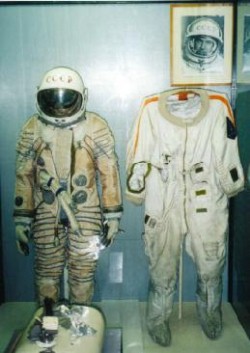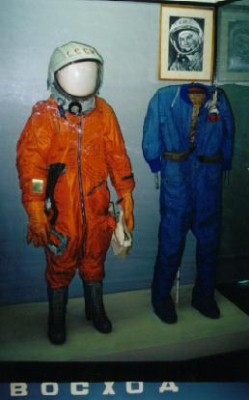ZVEZDA MUSEUM


Iím starting with this photo because it represents an unexpected completion of a circle in life. The display in the photograph relates to special event in the race to space and the race to space goes back a little farther for me. Two years before this event, in the fall of 1958, I was beginning my senior year in high school. I choose as my senior paper theme the sad state of affairs in the U.S. space program as compared to the U.S.S.R.ís. All the space firsts of that time were of great interest and the Russians seemed to be making most of them. The 1961 World Book Annual Supplement for the events of 1960 says about this event: "The first living beings to return from orbit were brought back by the Soviet Union on August 20. Russia orbited Sputnik V, a five-ton space Ďcabiní on August 19. In the cabin, separated by a glass partition, rode two female space dogs, along with rats, mice, fungi, flies, and plant seeds. The animals were lofted to determine the physiological effects of the space ride." Now 40 years later I am standing in front of a display of the capsule that contained the dogs and their life support system. I think I even recognized the dogs in the picture! Strelka is the white dog with colored ears and the little black vest. Belka is the solid white dog. (Their names are printed in Russian on the label at the bottom of the picture. Notice that the poster illustrating crew escape systems is in English.) The dogs pictured above the frame are descendants of the space dogs. There were a bunch of those small dogs running around on the grounds of Zvezda. I looked at the picture in the encyclopedia to be sure of my facts and found that a black dog with a white facial stripe was in the picture with Strelka, but the caption referred to Belka. (The dog with the white stripe in this photo is not the one in the encyclopedia photo.) I donít know how that mistake came about; I assume this photo is correct. Thanks to Raul Blanco for taking this picture. He is in the next photo and it completes another circle. It is connected to my experience as a test subject in the mid 60ís.
I will also mention here the experiment with dogs at vacuum. The experiments were performed by the U.S. in the early Ď60ís. There was a 100% survival rate for dogs exposed to vacuum for about 30 seconds. The survival rate dropped to 50% for those exposed to vacuum for 2 minutes. (None survived the autopsies!) I had heard about the experiments for years and then finally saw a printed report from the JSC technical library. Only microfiche copies remained the last time I checked. At another time and place I will tell how one of our test subjects suffered a brief exposure to near vacuum and survived. Arthur C. Clarke is supposed to have checked this out before he wrote the scene in 2001: A Space Odyssey of an unprotected astronaut transferring through vacuum into an airlock and then performing an emergency repressurization before losing consciousness.



The suit on the right may have been an earlier suit.


The photo on the right shows a display of the Mir Orlon EVA space suit. It is the type that was being tested while we were there. It was later shipped to the U.S. and the Russian team came to our test facility to do a joint space suit test in our Space Station Airlock Test Facility at the Lyndon B. Johnson Space Center in Houston, Texas.
| PAGE ONE - Flight to Moscow by charter jet. Visit to the famous open-air market. Red Square and St. Basil in the snow. Kremlin tour. The new mall. Currency exchange, a 500 ruble note, and a glass crystal egg. |
| PAGE TWO The week a Zvezda (Star) - Zvezda designs, tests, and manufactures space suits, life support systems, and aircraft ejection seats. We went to their plant on the outskirts of Moscow, toured their museum, and observed the manned vacuum chamber test. We made a night visit to Red Square and another subway trip to the Starlight Diner. |
| PAGE INWORK |
| ZVEZDA SPACE MUSEUM - Several photos of the displays with commentary. Zvezda built the capsule and life support system for the first dogs in space. There was a big display about that. All the early space suits were diplayed. The spacecraft and airlock from which the world's fist EVA was made was on display. |
| Space Suit Test at Zvezda - The whole purpose for the trip was to observe an actual manned test of the refurbished Orlan spacesuit that was brought back from the Mir by the Shuttle. These photos show the vacuum chamber (vac-camera), the control consoles, the Orlan suit suspended in the chamber, and Gennady, the expert suit engineer and test subject. |
| Jemma Mitchell's MOSCOW PHOTOS - Moscow in summer. Red Square, St. Basil, GUM, Kremlin, Lennin's Tomb, Views of the Kremlin from across the Moscow River. |
| Cycling Moscow to St. Petersburg - This is a really fun travel article. Some great photos around Moscow and out in rural areas. Photos of those who participated in the trip organized by Russian families and promoted on the web. The photos and story get better page after page. Seven great pages in all. |
| Another MOSCOW Journal - Journal and photos of a man who visited three months after my visit. There are photos of many buildings and some fine artwork from the subway. There is a great photo of one of the Patriotic Sculptures in the subway. It depicts a sitting woman with a rifle. I think I saw it during my subway travels. Part 2 has some copies of paintings from the nineteenth century and photos from the subways. |
| Marina's Moscow - A young woman of Moscow displays travel photos and interesting information about Moscow. |
| SITE INDEX |
This set of pages is under construction. Some links may not work yet. (12/11/02)
|
GUESTBOOK ONE View My Guestbook  Sign My Guestbook
Sign My Guestbook
|
|---|
|
GUESTBOOK TWO View My Guestbook Get Your Free Guestbook |
Re-posted: 1/2/03